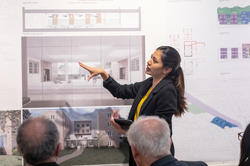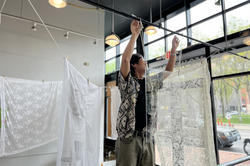Grad students in a spring Interior Architecture studio worked with real-world client FamilyAid.
RISD Studio Promotes Activism Through Graphic Design

In a spring Graphic Design studio called Be the Change, faculty member Rene Payne 83 GD asked students to imagine and design real-world interventions that lead to social change. The three major projects throughout the semester were guided by the key phases of activism derived from the philosophy of artist/activist and 2017 MLK keynote speaker Emory Douglas: inform, enlighten and educate.
At the beginning of the semester, students explored individual notions of security, ranging from their personal experiences with climate change to racism to religion and more. They worked closely with RISD’s Center for Complexity (CfC) to learn directly from Providence community members of all ages what security meant to them and then designed detailed informational kits that communicated the individual perspectives gathered.
A kit by Erin Roman 23 GD conveyed a message about animal cruelty via an informational poster and stickers. Emma Caamaño 24 GD designed an emergency care kit for the elderly, and Chancellor Joyer 24 IL put together a box that unpacks the effects of racism on adolescent girls.


The notion of security acted as a foundation for the course’s second design project, which called on students to use symbols to educate the community about local resources, such as AIDS Care Ocean State and Save the Bay. At a mid-semester critique, Caamaño presented SMS Motherhood, an open-type glyph set, informational guidebook and handmade quilt featuring the symbols she designed. The project speaks to the experience of motherhood outlined in Michelle Millar Fisher and Amber Winick’s popular book Designing Motherhood (MIT Press, 2021).
“The quilt you created is really quite wonderful,” said visiting artist Gina Belafonte. The CEO of arts activism organization Sankofa consulted with the class throughout the semester. “I love your attention to detail and desire to create a space for people to deepen their connections to motherhood, whether they are male, female or nonbinary.”
Angela Um 24 GD took a different direction by designing Be Aware, a system to educate the public about hidden security cameras. Um designed a series of posters with QR codes that, when scanned, bring the user to a site that provides information about how to check for hidden cameras. “I feel you’ve really taken your work to another level,” Payne said during the crit. “Not only did you explore the symbol, but you worked through your own challenges around typography, and your photography is very well done. It really speaks to what the assignment is all about.”


“The students put a great deal of time, thought and sensitivity into considering how their work can bridge community and bring perspectives together.”
Towards the end of the semester, the third unit, which explored design as a way to propel new forms of civic action, shifted due to the Teamsters Local 251 strike at RISD that began midway through the course. Seeing the union action as an opportunity to document real-life moments of activism in a thorough and unbiased way, the students expressed interest in creating a digital archive that would consider multiple voices and perspectives. “After the strike, the RISD community felt isolated and separated,” says Caamaño. “Our goal is to put this archive together in a way that encompasses all viewpoints in the narrative.”
As part of the process, students spoke with Graphic Design Department Head Paul Soulellis about his experience fighting the erasure and oppression of specific voices that persists in many archives through his work with queer.archive.work. They also studied RISD’s approach to archiving historical moments on campus by visiting RISD Archives at the Fleet Library.
“We want to emphasize that certain people may not be able to contribute to the archive for legal reasons or otherwise,” says Alina Spatz 24 GD. “It is easy for students to see the administration as the bad guy, but we know that our viewpoint is limited to our personal experiences.”
When launched, the online archive will include imagery from the protests, transcriptions of interviews, links to information published by RISD as well as from external news sources. The site will also include a section that highlights the history of activism at RISD throughout its 146 years.
As the semester came to a close, Payne reflected on the students’ work. “I really love teaching the Be the Change studio,” she said “Each year the projects vary, but the one constant is the incredible work the students produce in the name of social equity through design. They put a great deal of time, thought and sensitivity into considering how their work can bridge community and bring perspectives together.”
Isabel Roberts
July 5, 2023


